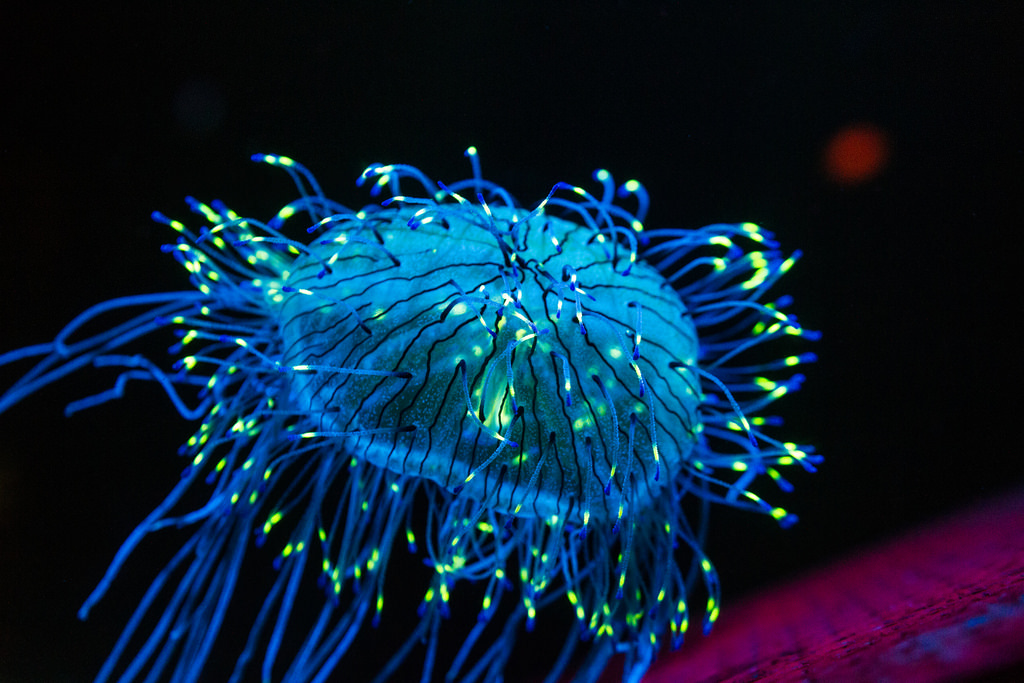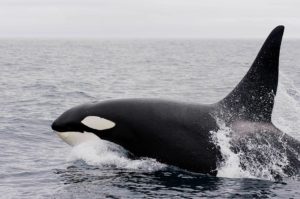Picture the scene. You’re 600 metres below the sea’s surface in a place known as the Twilight or Mesopelagic Zone. There is very little sunlight, it’s cold, but suddenly the water around you lights up with blue and green light! What’s going on?
This is bioluminescence, or the light produced by living things. Down in the deep sea, over 80% of all animals use bioluminescence, and as the deep is the largest habitat on Earth, this makes bioluminescence one of the most common means of communication on Earth.
How do animals make this light? There are two methods they can use. The first relies on a chemical reaction which takes place in cells known as photocytes, often housed in organs called photophores. The compound luciferin is oxidised by an enzyme called luciferase, and produces light (those of you who are/were UCD science students may remember this experiment in Biomolecular Lab Skills).
The second method uses symbiosis. Animals culture light-producing bacteria in special organs, such as the lure of an angler fish or the pouches beneath the eyes of a flashlight fish, and in return for producing light the bacteria get fed and a home.
So what’s the point? There are many uses for bioluminescence, many of which are not fully understood, and there may be many more functions that we haven’t come across yet.
My, what a pretty light you have…
The most famous use (probably down to Finding Nemo) is the use of bioluminescence to find prey. The most well-known is the deep-sea anglerfish. Females have a light-producing lure that hangs in front of their faces, and this glow draws other animals in to investigate where they are snapped up (males are tiny and parasitise females, so don’t have lures). Pacific blackdragon fish have a similar lure on their lower jaw which can be moved around to draw prey in.
Most bioluminescence is blue or green, but some creatures can produce red light. Red light is one of the first colours to disappear under water, and many deep-sea animals are coloured red as this makes them almost invisible. Emphasis on the almost, as the dragonfish and stoplight loosejaw have red searchlights that light up red animals hiding in the dark. As most animals can’t see this searchlight, the prey is unware that it’s been spotted until it’s too late.
Hide and Seek
Bioluminescence can also be used for defence. The hatchet fish lives in the Twilight Zone and has a line of photophores on its belly. When they light up, predators looking up find it very difficult to pick out the hatchet fish against the faint light from the surface. The velvet belly lanternshark also has these, as well as glowing dorsal fin spines that are believed to warn away predators. They also look like tiny lightsabers *zwoom*.
Some squid and polychaete worms use sacrificial body parts. These glowing bits can be detached as a decoy, and give the animal extra time to escape. Firefly squid are covered with shimmering lights that may help confuse predators, and they can also produce bioluminescent ink to further baffle them. Some deep-sea shrimp also do this, and if the predator gets coated in glowing ink then they themselves become more conspicuous to their predators. Life is tough kids.
Talk to me
It’s not all kill or be killed. Many animals use bioluminescence to communicate. The flashlight fish has shutters of skin which it can use to cover its glowing pouches. By opening and shutting them they can communicate with one another, almost like they’re using Morse code. Other animals, such as the cookiecutter shark, have species-specific patterns that they can use to signal to each other. Angler fish, crustaceans called ostracods and octopuses may use bioluminescence to signal their sex and attract mates. Sexy.
If you would like to have a question answered or see a particular topic mentioned, send me an email at science@ucdsac.ie
Stay nerdy folks
Danielle
Fast Facts:
- Pacific blackdragons are black (surprise surprise) but the lining of stomach is also black to prevent bioluminescent prey from shining through it and giving away the blackdragon’s position.
- Phosphorescence is the name given to the bioluminescent displays given off when the animals like plankton and dinoflagellates are disturbed. This is what causes glowing seas in the tropics as well as glowing marine mammals (this is a very cool video, 10/10 would link it in an article again).
- Biofluorescence is when an organism absorbs light and emits it as a different colour. We are just beginning to discover that marine animals do this too, from corals to sharks, turtles and even puffin beaks!
- Towards the end of World War I a German submarine was sunk by the British because it cut through bioluminescent plankton, thus giving away its position. During World War II the Japanese military used ground up sea-fireflies to read important documents rather than use more obvious man-made light.
- The short nose green-eye fish (scientists are great at naming things) has a green fluorescent pigment in its eyes, believed to help it tell the difference between bioluminescence and ocean water, and so see through bioluminescent disguises.
- Bioluminescence is believed to have evolved independently at least 40 times!
- Bioluminescence is a cold light and as such produces no heat.
- Most bioluminescent organisms are marine, but fireflies, glowworms and fungi are terrestrial examples.
Sources and Further Reading:
8 Marine Creatures that Light Up the Sea, Discover Magazine
How the Navy Tried to Turn Bioluminescence Against the Soviets, Atlas Obscura
Bioluminescence , NOAA
Bioluminescence, Smithsonian Museum of Natural History
Ocean: The definitive visual guide, Dorling Kindersley (2014)
True Facts About the Angler Fish , Ze Frank
The Brilliance of Bioluminescence, TED Ed
The Blue Planet, Episode 2: The Deep, BBC (2001)
Edith Widder: The weird, wonderful world of bioluminescence, TED Talks
David Gruber: Glow-in-the-dark sharks and other stunning sea creatures, TED Talks



Pingback: Divin' Into Science: Sharks | UCD Sub-Aqua Club